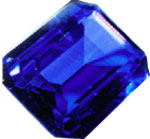Diamond Color Grading
The lack of natural body color is a major factor in determining the value of a diamond.

The most expensive are colorless and are graded downward by the amount of yellowish or brownish tint they have.It is only possible to accurately color grade a diamond if it is unmounted, placed on a white background and compared with a set of standard graded diamonds.
A mounted diamond picks up the color of the metal and always looks better set in white gold or platinum. Even then, one can only approximate the color of a mounted diamond within a range of a few grades.
The diamond color grades are as follows:
A mounted diamond picks up the color of the metal and always looks better set in white gold or platinum. Even then, one can only approximate the color of a mounted diamond within a range of a few grades.
The diamond color grades are as follows:

• D, E, F: Colorless. Loose diamonds appear colorless.
• G, H, I, J: Near Colorless. When mounted in a setting may appear colorless to the untrained eye.
• K, L, M: Faint Yellowish Tint. Smaller diamonds look colorless when mounted. Diamonds of 1/2 carat or more show traces of color.
• N - R: Very Light Yellowish Tint and
• S - Z: Tinted Light Yellow. These diamonds show increasingly yellow or brownish tints and appear very "off-white".
• D, E, F: Colorless. Loose diamonds appear colorless.
• G, H, I, J: Near Colorless. When mounted in a setting may appear colorless to the untrained eye.
• K, L, M: Faint Yellowish Tint. Smaller diamonds look colorless when mounted. Diamonds of 1/2 carat or more show traces of color.
• N - R: Very Light Yellowish Tint and
• S - Z: Tinted Light Yellow. These diamonds show increasingly yellow or brownish tints and appear very "off-white".
Diamonds with distinct natural body colors other than brown or black are considered "fancy diamonds" and some bring higher prices than the finest colorless diamonds. A bright red diamond of less than a carat brought almost a million dollars at auction in 1987.
Discerning the difference in color from D down to H in a mounted stone without direct comparison is very difficult. Yet a large D stone may cost three times an H stone of the same weight.
Because of other factors that contribute to the beauty of a diamond, there are many beautiful stones below an M color such as a very light yellow called "champagne" and a darker yellow/brown called "cognac".
In diamonds over one carat, the color effects the value more than in smaller stones as it is more apparent. But choosing a lower color grade will reduce the price, and there will be little, if any, visible difference when the stone is mounted.
Discerning the difference in color from D down to H in a mounted stone without direct comparison is very difficult. Yet a large D stone may cost three times an H stone of the same weight.
Because of other factors that contribute to the beauty of a diamond, there are many beautiful stones below an M color such as a very light yellow called "champagne" and a darker yellow/brown called "cognac".
In diamonds over one carat, the color effects the value more than in smaller stones as it is more apparent. But choosing a lower color grade will reduce the price, and there will be little, if any, visible difference when the stone is mounted.
Most of the data on this page came from the book, Jewelry & Gems, The Buying Guide by Antoinette L. Matlins, PG & A.C. Bonanno, FGA, PG, ASA, published by GemStone Press, Woodstock, Vermont.

